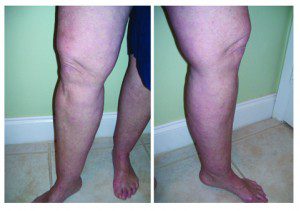By Joseph Magnant, MD, FACS, RPVI
 The issue of cankles (where the calf and ankle appear to have merged as one) was discussed several years ago on the daythe daytime MD entertainment talk show “Dr. OZ” and confusion still exists as to the relationship of this condition to venous insufficiency. Unfortunately, venous insufficiency was not included in the possible causes of cankles and this distressed me. I have seen many patients with similar appearing calves and ankles which have been self described as their Grandma’s ankles or stovepipe legs. As I caught the last segment of the show, I found it odd that Dr. Oz was missing VENOUS INSUFFICIENCY, as well as other causes, in the differential diagnosis list. Pregnancy, fatty foods and heart and kidney problems were identified as potential causes although the mechanisms were not well described. I saw many patients that day that had no obvious signs of varicose veins, heart failure or kidney failure, nor were they pregnant but most had what I refer to as “cankles”. All patients had ultrasound evidence of severe superficial venous insufficiency.
The issue of cankles (where the calf and ankle appear to have merged as one) was discussed several years ago on the daythe daytime MD entertainment talk show “Dr. OZ” and confusion still exists as to the relationship of this condition to venous insufficiency. Unfortunately, venous insufficiency was not included in the possible causes of cankles and this distressed me. I have seen many patients with similar appearing calves and ankles which have been self described as their Grandma’s ankles or stovepipe legs. As I caught the last segment of the show, I found it odd that Dr. Oz was missing VENOUS INSUFFICIENCY, as well as other causes, in the differential diagnosis list. Pregnancy, fatty foods and heart and kidney problems were identified as potential causes although the mechanisms were not well described. I saw many patients that day that had no obvious signs of varicose veins, heart failure or kidney failure, nor were they pregnant but most had what I refer to as “cankles”. All patients had ultrasound evidence of severe superficial venous insufficiency.
With an estimated 35-40 million adults in the U.S. affected by treatable superficial venous insufficiency, a significant number of patients may present with atypical signs, such as the above referenced “cankles”. Patients may have to urinate frequently at night, often have to loosen their shoes as the day progresses and may note restless legs when they lie down at night. Elevation even tually relieves their discomfort as the fluid in the legs returns to venous circulation. This returned fluid is then processed into urine by the kidneys, stored in the bladder and often necessitates frequent nighttime trips to the bathroom (nocturnal di-uresis). This straight forward
cycle repeats itself daily with increased venous pressure in the ankle area due to leaky vein valves, resulting in seeping of serum (water and protein) out of the thin-walled veins into the surrounding skin and fat (appearance of “cankles”) which progresses over the course of the day, until elevation and rest are possible.
I agree with Dr Oz that effective conservative therapy includes exercise, as this helps the calf muscles pump at least some of the extra fluid back up to the jugular vein. However, unless the most common and treatable underlying cause of “cankles” (venous insufficiency) is scientifically ruled out with duplex ultrasound examination, I would not encourage any of my patients to have liposuction of their “cankles”. Venous insufficiency should be considered and ultrasound evaluation completed earlier in the assessment of swollen ankles rather than as a last result. Venous insufficiency is treatable with a minimally invasive procedure called endovenous ablation. With 15 years of clinical experience, endovenous ablation is an effective and safe outpatient procedure which has dramatically changed the way patients with venous insufficiency.
Vein Specialists
1510 Royal Palm Square Blvd. #101 Ft. Myers, FL 33919.
3359 Woods Edge Cir #102 Bonita Springs, FL 34134.
www.weknowveins.com. www.eVeinscreening.com
239-694-8346








